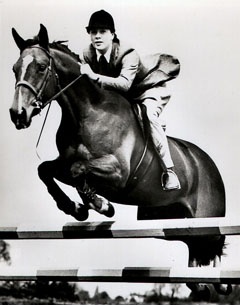
Nowadays it is usual to specialize on one equestrian discipline early and look for a proper horse, which is talented or bred for it. Although riders like Ingrid Klimke and Julia Mestern from Germany or Denmark's Niels Haagensen are successful in eventing as well as dressage they are a rather exotic exception and have different horses to use for each discipline.
Due to the particular development of equestrian sport today it seems very unlikely that a 46 year old, unique record will ever be equalled, let alone from a horse of similar diminutive size and breed. Tramella, a mare standing barely 15 hh by the thoroughbred Tramail xx out of a Welsh pony mare of unknown pedigree, is the only horse ever to win European Championship gold medals in eventing and dressage.
Foaled in 1946 Tramella was a bright bay horse with four white socks and a characteristic blaze and she looked very handsome. As she was a bit bigger than a pony the mare seemed to be an ideal horse for a teenage girl who made the transition from ponies to horses.
Mr. George Mason, an English farmer, loved the four year old mare and bought her for his 17 years old daughter Diana as a show horse for small hunters and hack classes. Diana had been lucky to have had ponies on the farm early on, but Tramella was her first real horse. The thrill didn't last too long because the new acquisition soon proved to be a very difficult little horse and even more so for an inexperienced teenager without a trainer. But Diana's father still liked the mare and Diana was taught an early lesson she is forever grateful for and from which she profited all her life: patience and persistence.
With her strong character Tramella very often had no intention of walking out the stable yard at the beginning of their partnership. Diana recall spending "many hours sitting on her, waiting for her to get bored – then she was fine!“ It was essential not to lose patience and never beat or punish the strong willed mare at any time during the struggles Diana had to face. Tramella would never have accepted it.
Somehow both found each other more and more and although Diana showed the very pretty mare successfully at show classes she soon took an interest in eventing too. This discipline seemed to be ideal for a nation crazy about hunting, but in the early 1950s Great Britain was only at the beginning of its story of success, which still goes on to date.
Diana had the opportunity to ride with John Shedden, the first ever winner of Badminton in 1949, for some time so she wasn't completely clueless when she started Tramella in their first one-day-event in Wellesbourne in 1951. However, both were eliminated in the show jumping phase.
Only a week later both showed talent and won at Epperstone ahead of the experienced John Oram on two of his potential Olympic horses for Helsinki 1952. Diana continued to event throughout 1952 with much success and so the idea arose to start at Britain's even then most difficult three-day-event at Badminton.
Although the Welsh crossbred was very small and had to carry a minimum weight of 75 kg in a three-day-event Diana „never had any doubts about her physical ability. Tramella always enjoyed the whole eventing game." Badminton in the 1950s was less technical than today, but the fences were still very imposing and the horses had to do 17,5 miles on cross-country day, which included a steeplechase course before the cross country itself.
Diana and Tramella had never seen fences of Badminton's type and size before, let alone a steeplechase. So Diana took her diminutive lady down to the local race course and jumped "Mell," as she affectionately nick-named her, over the fences. "I did it all on my own. Ignorance is bliss," Diana admitted to Eurodressage.
Whereas ladies have proved to be equally if not even more successful in eventing than men in the 1950is women were an attraction in this strenuous discipline. Diana was just 20, Tramella only 7 when both tackled Badminton for the first time in 1953. After a spooky bad dressage both came 19th in the end, so they had more than just survived.
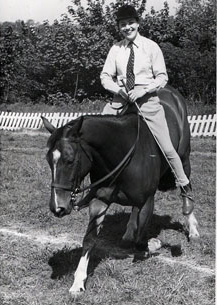 A year later Badminton saw the breakthrough of the ladies and Tramella and Diana were strongly involved. This time Mell was worked-in for five hours before the dressage and it worked. The mare had talent for it, but could easily get excited, so everybody was happy with her 2nd place. At the end the lively horse finished in an outstanding third place behind Diana's friend Margaret Hough, who won the first woman ever to win on Bambi.
A year later Badminton saw the breakthrough of the ladies and Tramella and Diana were strongly involved. This time Mell was worked-in for five hours before the dressage and it worked. The mare had talent for it, but could easily get excited, so everybody was happy with her 2nd place. At the end the lively horse finished in an outstanding third place behind Diana's friend Margaret Hough, who won the first woman ever to win on Bambi.
Apart from her remarkable performance Tramella made headlines at Badminton for being maybe the only horse ever to curtsy in front of the Queen, entirely on her own! Diana had taught the mare to bow and as Mell always got a lump of sugar for it she bowed every time a visitor looked over her stable door in Badminton. It was no different when the Queen Mother did it and she called her daughter, Queen Elizabeth II, to have a look at it. Both seemed, according to Diana, quite amused about her obedient subject.
Four years after she had caused so much trouble for her young owner, Tramella made Diana the first woman ever nominated for a British equestrian team. Both were chosen to compete in the 1954 European eventing championships in Basle and found themselves on a small plane to Switzerland. Diana and her friend Margaret Hough, who rode as an individual, remained the only women at Basle, where according to the now 76-year old Diana „everyone was interested to see how the girls survived.“
They did and in what a style, over a course which will be remembered as one of the most difficult of the decade. The cross country was huge with fences up to nearly 5 foot and 22 miles to cover on cross country day. No surprise it caused a lot of trouble with nearly everybody having one fall or more. Tramella stayed on her small feet throughout cross country on a very wet and hilly ground. But once she turned very sharply on landing over a fence to avoid a drop and a tree, Diana fell off. The mare was in an excellent condition the next day and finished 7th place individually and contributed enormously to Great Britain's European team title. For young Diana "it was the most amazing experience."
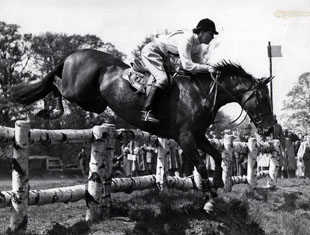 It looked like the promising beginning of an international eventing career for this female dream team and the opportunity to crown themselves on home turf came in 1955 when Windsor hosted the European championships. Tramella was in the lead after an outstanding dressage test but she slipped on the cross country course on the landing over a fence and fell. The brave mare had never fallen before in her life and it gave her such a fright that Diana had to retire her. Mell's confidence was seriously shattered after Windsor and she didn't want to jump on slippery ground from then on.
It looked like the promising beginning of an international eventing career for this female dream team and the opportunity to crown themselves on home turf came in 1955 when Windsor hosted the European championships. Tramella was in the lead after an outstanding dressage test but she slipped on the cross country course on the landing over a fence and fell. The brave mare had never fallen before in her life and it gave her such a fright that Diana had to retire her. Mell's confidence was seriously shattered after Windsor and she didn't want to jump on slippery ground from then on.
Diana already had an interest in pure dressage and since her mare obviously didn't enjoy eventing anymore she decided to change her into a dressage horse. Dressage as a discipline was very much in its infancy in Great Britain of the 1950s. There was not much help for interested riders and it was no different in Diana's case. But she was inspired from her visit to the 1956 Olympics in Stockholm where she had seen her first Grand Prix and was convinced Tramella had a chance to get to this level one day and maybe make her an Olympian in Rome 1960. There were no serious doubts about the mare's diminutive size whether this were to be a disadvantage in dressage. During those days many riders just worked with the equine partner available, no different for the British ladies, and only few were already able to buy a ready-made dressage horse.
Tramella was the first horse Diana did advanced work with in dressage. She never even sat on one before so it was very much learning the ropes together without regular instruction.
Foreign trainers like famous German Felix Bürkner or the legendary leader of the Spanish Riding School, Colonel Alois Podhajsky, came for a few days each year to give clinics. Diana and Tramella attended them, but profited also from helpful advice of friends. "I also learnt much from books, not a particular one, for example how to teach my horse flying changes," Mason confessed.
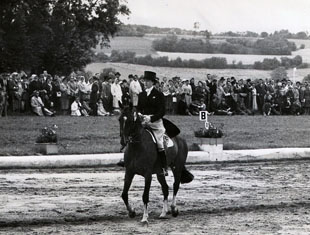 Tramella matured into a lovely little dressage horse and was an eyecatcher with her elegant rider, though Diana believed "I could have done a better job with more experience." Tramella became a Grand Prix horse at the age of 12, only three years after she had quit eventing. She was then one of only 6 or 7 horses at that level in Great Britain and allowed to compete on the holy grounds at Aachen for the first time in 1959, where Tramella placed 3rd in an M- class and 8th in the Prix St. Georges. The mare's strength were her walk and trot work. The walk was exceptional and she was even given a 9 for it once at Aachen.
Tramella matured into a lovely little dressage horse and was an eyecatcher with her elegant rider, though Diana believed "I could have done a better job with more experience." Tramella became a Grand Prix horse at the age of 12, only three years after she had quit eventing. She was then one of only 6 or 7 horses at that level in Great Britain and allowed to compete on the holy grounds at Aachen for the first time in 1959, where Tramella placed 3rd in an M- class and 8th in the Prix St. Georges. The mare's strength were her walk and trot work. The walk was exceptional and she was even given a 9 for it once at Aachen.
1960 was an Olympic year and Diana took Mell to the CDIO Rotterdam where she placed highly in the Intermediare I and the Grand Prix. Unfortunately the FEI had decided to cut the team competition in Rome in order to keep dressage an Olympic discipline and allowed only two individual riders from each nation. This was not to Tramella's advantage as she was the third best British horse and so only nominated as the reserve, which was still an achievement.
The same year the versatile mare became the Hunter Champion in Rotterdam where she also had to jump. Jumping remained a favoured thing for Tramella and Diana remembers how much her mare enjoyed Aachen every time, since in those day the dressage horses had to jump a little jumping pole after the ride to prove their obedience. Whereas Mell had no problems at all Diana remembers that more famous horses struggled: European Champion Wolfdietrich refused and was eliminated one year, in another Olympic Champion Sergej Filatov's Akhal Teke Absent jumped from passage over the pole.
After Tramella placed below the top 6 in Hamburg, Cologne and Aachen in 1961 Diana tried to get her in foal the following year, but with no luck, so she returned to competition aged 17.
Mell was a horse of exceptional health, never a day lame in her whole life and with no signs of wear until the end. So 9 years after her first European championships in eventing she attended her 2nd one, this time in dressage, at Copenhagen in 1963. Though the FEI still called it „unofficial“ it was the first time the competition was claimed „European championships“.
The British ladies' team had three interesting horses at Copenhagen: the ex-eventer Tramella, the even smaller Connemara-thoroughbred crossbred Little Model of Mrs. Lilian Brenda Williams and the Lipizan Conversano Caprice with his rider Joanna Hall, who later became an international dressage judge. They may have been less brilliant than an outstanding horse like the Swedish chestnut Wolfdietrich, who became the individual winner with Swiss Henri Chammartin, but together they were able to win the team title far ahead of the second placed nation. Tramella herself hated the muddy footing in Denmark, but she was writing history there by winning another European championships title in a 2nd discipline -- the only horse to date to have ever done so. The same year she placed 2nd in the Grand Prix at CDIO Rotterdam and became Hunter Champion for the second time.
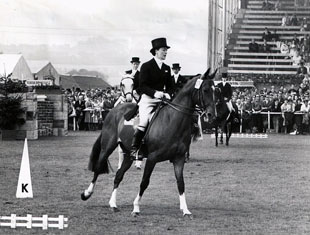 1964 was Mell's last year of competition and it brought a much treasured victory at CDIO Aachen. She won an S-class for foreign riders and proudly led her lap of honour with ears pricked in the main stadium. After this victory Diana decided to retire her 18-year old faithful companion.
1964 was Mell's last year of competition and it brought a much treasured victory at CDIO Aachen. She won an S-class for foreign riders and proudly led her lap of honour with ears pricked in the main stadium. After this victory Diana decided to retire her 18-year old faithful companion.
Tramella enjoyed her retirement in the pasture with her friend Pericles, who became Diana's next international Grand Prix horse. Mell stayed in the centre of her rider's attention, as she was the only person ever to ride and groom the intelligent little lady. Mell also only allowed Diana to rasp her teeth as she hated vets and reared every time.
At the age of 23 Tramella leapt back into the limelight when she was invited to take part in the "Parade of Personalities" at the famous Horse of the Year Show. She was fit enough to give a little show twice a day for a week, which she enjoyed very much.
In 1974 Mell was 28 and though still looking great she started to get stiffer so Diana made the hard decision to put her beloved friend of 24 years to sleep, because "I never wanted her to suffer."
Tramella's place in the history books is secured forever as well as in Diana's heart: "Mell was the love of my life and it is entirely due to her that I got involved in all aspects of dressage over the years."
Article by Silke Rottermann
The author likes to thank Mrs. Diana Mason for her tremendous help and support in writing this article.
Photos courtesy: E. Cornaz, Rex Coleman, private
Video Clip: Check out Diana and Tramella. You can see Diana patting Tramella, them before the start and a cross country at Harewood Horse Trials 1955.
Related Links
History Record of the European Eventing Championships
History of the European Dressage Championships - The Winners
Greatest Oldies: Mariano, the First World Champion in Dressage
Greatest Oldies: Absent, An Akhal Teke on the Olympic Stage
Greatest Oldies: Pepel, A True Legend of Russian Dressage